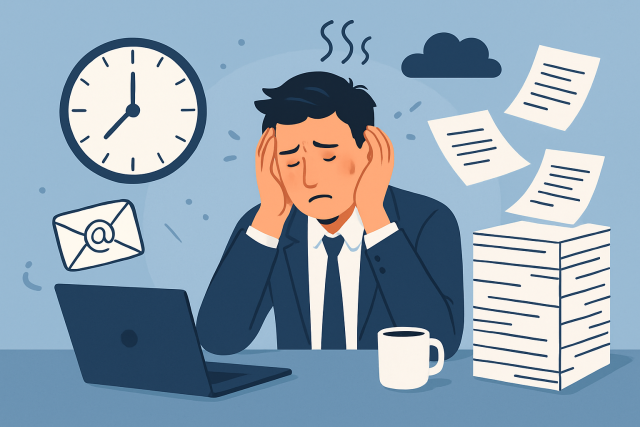
What Is Work Stress and How Does It Affect Your Health?
Work stress affects millions and can harm both mental and physical health. Learn what it is, how to...
This article takes a close look at how therapist burnout creeps in and shares practical tips to help prevent it and keep you feeling your best for the long haul.
Therapist burnout is a tough hurdle that many mental health professionals wrestle with. It often sneaks up as emotional fatigue and leads to care that’s not quite as sharp. It also brings some personal challenges that are hard to shake.
Therapist burnout usually creeps up rather than hits all at once because of the constant grind of work stress and the emotional toll of connecting with clients. It also happens when there is not enough support at the workplace.
Burnout usually sneaks up with subtle early symptoms and if you don’t catch them in time, they can slowly snowball into something much harder to shake.

Managing therapist burnout well calls for a thoughtful blend of proactive steps like prioritizing self-care and setting clear professional boundaries. It also involves leaning on support from the organization.
Start by taking a good honest look at yourself to catch early burnout signs before they turn into something worse. It helps to set solid boundaries like carving out clear work hours, shutting down your devices once the day is done, and getting comfortable with saying no when your to-do list feels overwhelming. Building self-care habits is a game changer too. Regular exercise, some mindfulness, and enough sleep all play a part in keeping your resilience up. Having a supportive circle—whether peers or supervisors—creates a safe harbor where you can unload about tough cases or emotional stress. In my experience this cuts down on that lonely feeling. Tools like planners and scheduling apps are your friends because they help make the workload feel less like juggling flaming torches. Staying in the loop by attending workshops or courses about burnout often provides practical coping strategies that really stick.
Regularly touching base with clinical supervisors and peer support groups isn’t just a good idea—it’s a lifeline that offers valuable insights and a safe space to let your emotions breathe. Going into these meetings armed with prepared topics about tricky cases and your personal reactions can really help you squeeze the most support out of the experience.
Organizations play a key role in easing therapist burnout. Clinics and agencies often hit their stride when they put policies in place that keep caseloads reasonable and encourage honest communication. They also embrace leadership styles that make important employee well-being and continuous professional growth.
"Being therapists isn’t just about having resilience in your back pocket. It genuinely calls for deliberate self-care, setting clear boundaries that actually stick, and surrounding ourselves with a supportive environment. Keeping burnout at bay is absolutely important if we want to hold onto our ability to genuinely help others." – Dr. Lena Thompson, Clinical Psychologist
Burnout tends to creep in as ongoing exhaustion and a sense of detachment from your clients. You might notice a dip in how effective you feel that doesn’t shake off with a good night’s sleep. Unlike everyday stress, these symptoms stick around and slowly mess with your work. Early red flags include feeling emotionally numb, running on empty, and getting irritable over little things. If these vibes last several weeks, you have probably stepped into burnout territory.
Building simple everyday habits can make all the difference. Think mindfulness routines like meditation, about 30 minutes of physical activity, and aiming for a solid 7 to 9 hours of sleep. Don’t forget to make room for hobbies and social time as a way to hit pause on work and recharge. Keeping these rhythms steady helps rebuild your resilience and wards off emotional burnout better than you might expect.
Boundaries aren’t just a nice-to-have—they’re critical for your well-being and giving your best care over the long haul. Start with baby steps: set clear work hours, gently avoid messages outside those times, and don’t be afraid to delegate when the plate’s overflowing. Here’s a little secret: setting boundaries actually makes you a better therapist by keeping you fresh and effective.
When change feels slow or non-existent, try planting seeds by sharing burnout research with your leadership. It might plant a thought or two. Meanwhile, focus on what you can control: lean on supportive peers, master your time-management, and take much-needed mental health days. If the environment stays tough, it’s worth considering a place that truly values wellness—you deserve that.
Absolutely. Many therapists find their own therapy to be a lifeline for navigating secondary trauma and juggling stress. Seeking your own support isn’t a sign of weakness—it’s a smart proactive move that models healthy coping and deepens your self-awareness. In the end, it makes you stronger at what you do.

Work stress affects millions and can harm both mental and physical health. Learn what it is, how to...

Discover how specialized therapy for generational trauma breaks cycles of inherited pain, offering p...

Language processing disorder impacts how children understand and use language. Learn to recognize ea...

Spotting the signs of a toxic relationship early can save your emotional health. Discover key red fl...